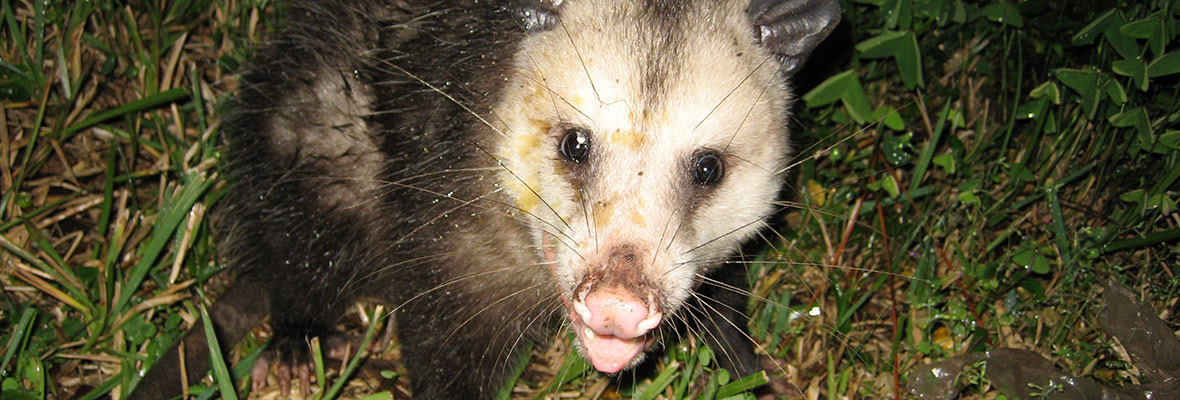- info@animalatticpest.com
- Call - we service 300 locations
Opossum Biology, Life Cycle, Habitat, Diet
Whether you have an interest in learning more about the wildlife around your home or want to better understand them as a way to keep them off your property, finding out more about opossums can be a very interesting endeavor. Keep in mind that possums and opossums are the same thing; they are just two different terms used for the animal.

Appearance And Biology
There are actually 60 species of opossums, with the common opossum or Virginia opossum being the most common. This is actually the only marsupial, meaning pouched animal that is found in Canada and the United States. Opossums have sharp claws that help them dig into the bark of trees while climbing. They also have a long gripping tail which they use as an additional limb during climbing. The rear limbs have clawless, opposable thumbs. These prehensile tails are hairless. Possums have hairless ears and a pink nose at the end of their flat, long snout.
Opossums can vary greatly in size. The average one will be around the same size of an average house cat, but they tend to be smaller in the tropical areas and larger farther north. Their fur is usually gray but it can be anywhere from black to brown to white due to variations in their guard hairs. These guard hairs can also vary in thickness. Their mouth holds the most teeth of any mammal in North America, 50.
Life Cycle
Although a litter of opossums may have up to 20 babies, less than half of these animals will survive on average. When opossums are born, they are as small as honeybees and completely helpless. Babies will crawl into their mother’s pouch immediately, which is where they develop and stay safe. Not all of the newborn opossums will make it this far. Eventually, the possums get larger and occasionally leave their pouch. They will also ride on their mother’s back while she goes out in search of food.
Habitat
You can find the Virginia opossum throughout North America and Central America to the east of the Rockies. They span from southern Ontario to Costa Rica and are expanding their range north. These animals are native to the eastern portion of the U.S. but were intentionally spread during the Great Depression. Possums tend to live by or in wooded areas, particularly those that are close to water. They are also frequently found in urban areas. Since they are excellent climbers, it is not uncommon for possums to nest inside of tree holes. They can also frequently be found in dens that were previously made by different animals. Opossums don’t build shelters themselves so you can find them in old buildings or sheds as well or in fallen logs, hollow trees, and cavities in brush piles or rocks. They will bring nesting material to their chosen shelter.
Diet
Possums are scavengers, which means they will eat whatever food they can find. Because of this, they will frequently be found by human homes, raiding dumpsters and garbage cans. Opossums will also carrion, which is why you will frequently find them by roadkill. Additionally, these animals eat fruit, nuts, and grass. As omnivores, they also hunt birds, mice, worms, insects, and snakes as well as chickens. Possums have a relatively small brain, but are able to find food as well as remember where they found it. In fact, opossums scored better than cats, rats, rabbits, and dogs in some tests for their memory. They can also remember how toxic or noxious substances taste.
Behavior
Perhaps the most common possum behavior is “playing possum.” This is their defensive mechanism that naturally occurs when they are threatened by a predator, such as a bobcat, fox, or dog. They will flop on their sides then lie on the ground. Their eyes will either be closed or they will stare into space with a fixed view. At the same time, these marsupials extend their tongues to complete the impression that they are dead. This has proven to be an effective way to put predators of guard and give the animals the chance to escape.
Possums are not typically aggressive, but they do have a defensive posture when threatened. If cornered, they will either sit back or crouch down and open their mouth. This displays as many of their teeth as possible. This action is accompanied by screeches or growls that tend to get more intense.
Opossums are also great climbers, spending a great deal of their time in trees. Their biology helps with their climbing capabilities. If caught and then handled, possums will frequently defecate and the glands by the base of their tail will release a secretion that is pea-green. Possums are mostly nocturnal, typically foraging after dark. When it gets colder out, such as during winter, they are more likely to be active during the day since they need to eat more.
Opossum Biology, Life Cycle, Habitat, Diet
How To Keep Opossums Away
What Kind Of Damage Can Opossums Cause?
Opossum Feces – Appearance And Health Risks
How To Kill Opossums
Baby Opossum Nest In The Attic
Opossum Repellent Natural Home Remedy
Opossum Trapping Methods
